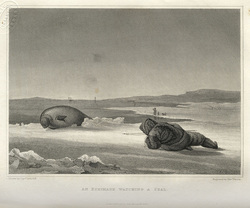 At last, we return to the cold regions of the continent of North America and though I am sharing only a few of the many Inuit Legends, it is well worth to visit the sites where I cite these legends. I feel very few know of these traditional myths! The Inuit came into North America from Siberia crossing into Alaska via the Bering Ice Strait and replacing the Thule Culture that inhabited most of the Artic regions of North America. They centered their myths around the natural world and in the instance below, what was the most important to them and their life, the sea. Sedna: Inuit goddess of the Sea and the Underworld, which is coincidentally, the bottom of the sea. Though there are variations in the story, seals supposedly were spawned from her own fingertips that were cut off by her father as she attempted to hold on to the side of his boat. Yes, at one time, she was actually a mortal. Though she was prideful, unhappy that her home was not as extravagant as she wishes. (Come on, who wants fish skin beds when reindeer beds are much more comfortable. Sedna was actually from another land but had married and came to North America.) Her father had came to "rescue her" after she plead to him to take her from her lowly existence. But when a storm struck his boat, he tried to sacrifice her to end the storm. *father of the year award goes to: Sedna's Father!* After he cut off her fingers, he felt bad and pulled her back into the boat. Taking her back to land and her lowly estate, Sedna attempted to punish her father by letting dogs tear off his hands and feet, he cursed her and the earth opened up swallowing him, her, and the hut she lived in. It was from then on, she became a goddess, and ruler of the city of the underworld, Adlivun. I'm not sure how being prideful and cursing your father earns you the right to be a goddess, but this is their story not mine! If you happen to come across that reason or know it, let me know, I will change the info here! The Northern Lights It seems that the Northern Lights and their meaning varies greatly depending on which Inuit tribe spoke of them. The most common theme: dead ancestors. A tribe in Greenland believed that they were the spirits of infants that died at birth. Another tribe believed it was actually a game where spirits played "ball" with an animal head, and then those of Nunivak Island made it more morbid with the claim it was a human head. At Point Barrow in Alaska, there was a tribe that believe it was an evil entity that needed to be hidden from. They went as far as to sleep with knives under their pillows. Though, I doubt this would've been enough if it was an entity of some kind. I actually have a similar belief in my book, Winemaker of the North! My favorite summary is taken from an explorer named Ernest W. Hawkes, who wrote: "The ends of the land and sea are bounded by an immense abyss, over which a narrow and dangerous pathway leads to the heavenly regions. The sky is a great dome of hard material arched over the Earth. There is a hole in it through which the spirits pass to the true heavens. Only the spirits of those who have died a voluntary or violent death, and the Raven, have been over this pathway. The spirits who live there light torches to guide the feet of new arrivals. This is the light of the aurora. They can be seen there feasting and playing football with a walrus skull. The whistling crackling noise which sometimes accompanies the aurora is the voices of these spirits trying to communicate with the people of the Earth. They should always be answered in a whispering voice. Youths dance to the aurora. The heavenly spirits are called selamiut, "sky-dwellers," those who live in the sky. " If I had a single favorite aspect of Inuit myths, it would be those of Aurora Borealis, or its common name, the Northern Lights. There wonder inspired the original Winemaker of the North idea and is a consistent presence across all three books. The Inuit myths, though only touched briefly upon here, have some of the very similar myths as the more southern native American tribes which such characters as the Raven, a common appearance in other myths. I have enjoyed exploring these myths and sharing a few tidbits of what I have found. I hope you too, have enjoyed it! Thank you for reading! JT Click as appropriate if you are looking for either Finnish Myths or Hawaiian Myths! For further reading, go to these sites: http://www.native-languages.org/inuit-legends.htm http://www.indigenouspeople.net/aurora.htm |
Archives
May 2023
Categories
All
|
J.T. WilliamsJoin the J.T. Williams mailing list to be notified of new releases and other news!
|
|

 RSS Feed
RSS Feed
